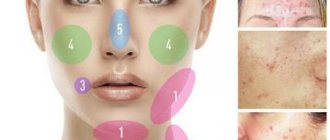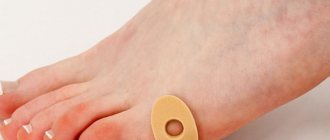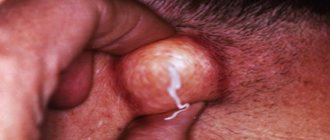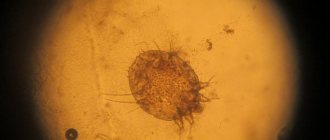Problems with skin rashes are often associated not only with adolescence in adolescents. Sometimes the most harmless small pimple can turn into an inflamed abscess, followed by slow healing. Many adults already know where purulent pimples can appear. As a rule, they can rash in the face, back, chest, and so on.
Suppuration of a pimple can be a consequence of self-squeezing out the acne. Lack of sanitation leads to numerous inflammations, and effective treatment of purulent acne already requires the intervention of antibiotics.
It's no secret that frequent purulent rashes spoil the skin and worsen the appearance, but few people understand how dangerous these inflammations are for the human body as a whole. After all, inflammation can spread to healthy areas and instantly spread through the blood throughout the body.
Causes of purulent acne
The human body is a well-oiled mechanism, but still, for one reason or another, it can malfunction. The doctor can make an initial diagnosis based on the skin and oral cavity. But for a complete diagnosis, the doctor needs to understand the characteristics and reasons for the appearance of purulent acne in the patient, and this, as a rule, is only shown by additional studies.
Very often, after examinations, it becomes clear that purulent inflammation, both on the face and throughout the body, is a consequence of improper functioning of the gastrointestinal tract, a malfunction in the hormonal system, allergic reactions, and so on.
The main factors that provoke inflammation of acne:
- clogged pores due to increased activity of the sebaceous glands and sweating;
- thickening of the epidermis and poor renewal;
- taking hormone-containing drugs;
- regular use of antibiotics leads to the formation of pus much faster;
- during menopause in women, as well as as a precursor to menstruation;
- Constant stressful situations lead to malfunction of human organs, which also causes the formation of suppuration.
As a rule, modern people experience constant stress. It’s rare that you have the opportunity to visit a beauty salon to cleanse your skin. Many people do not pay much attention to acne breakouts and are in no hurry to properly get rid of the skin problem.
The inability to regularly perform skin cleansing procedures and obtain competent advice from a specialist leads to the fact that products are purchased independently, regardless of skin type.
It is very important to remember that when choosing cosmetics, you should take into account all the features of your skin. Also, frequent use of decorative cosmetics, including foundation and powder, can lead to irritation on the facial skin.
With their regular use, the pores become clogged and begin to become inflamed. But illiterate people continue to mask the pimple with foundation, thereby provoking greater suppuration.
An important factor in the appearance of a rash can be allergic reactions, malfunctions of the immune system, bacteria, and so on. It is forbidden to touch pimples and acne on the skin with dirty hands, much less squeeze them yourself.
The main stages of the formation of ulcers
Doctors distinguish several stages in the formation of purulent acne on the skin of the face and body:
- pollution and blockage of pores with excess sebum;
- development of the inflammatory process;
- the appearance of the first pimple;
- progress of the disease (the appearance of many pimples, the formation of pus).
Human skin is designed in such a way that it renews itself (on average, once every 1-1.5 months). Outdated, dead cells are removed, and new ones take their place. Renewing the skin helps our body resist the negative effects of the external environment (sun rays, dust, etc.).
The formation of pus in a pimple is the last stage that cannot be ignored. In other words, we didn’t notice the clogged pores, didn’t clean them in time, and gave up on inflammation and the appearance of a small pimple. And only a large, painful abscess makes us sound the alarm.
NOTE!
To quickly get rid of blackheads, acne and pimples, as well as to rejuvenate your facial skin, we recommend that you familiarize yourself with this effective remedy .
Find out more...
How does a purulent pimple appear?
The manifestation of the process of inflammation on the skin begins with the appearance of a small red rash, which subsequently turns into swelling, and then into a purulent pimple.
Increased activity of the sebaceous glands leads to frequent inflammation, so this type of skin should be constantly treated with special products. For example, cleansing and drying tonics.
A purulent pimple is an inflamed area of skin, in the depths of which a purulent core appears in the center, and in the process of ripening it forms a dense inflamed lump.
The rod itself appears as a result of poor skin care or lack thereof.
It takes about two weeks from the moment a small red dot appears until the abscess fully matures. The larger the abscess, the greater the chance of getting a deep scar, which is called post acne, if you squeeze it out on your own.
Often carefully looking at unedited photos of purulent acne on people’s faces, many begin to think about skin care and maintaining it in proper form.
- atrophic gastritis treatment
- Men's signets: old new trend
- 3 types of medical gloves and why you should buy them in the MEDSTOR online store
Causes of ulcers
If skin care is really chosen correctly, but ulcers still form, what could this be due to? Doctors name several different reasons:
- increased sweating (result – rash on the back, shoulders, chest);
- hyperkeratosis (may be hereditary), when the upper layers of the epidermis quickly become coarser and the pores expand;
- long-term use of antibiotics, hormonal drugs;
- hormonal changes in the body in women (before menstruation, during menopause);
- prolonged depression and stress (affect hormone production);
- noticeable lack of vitamins (especially group B);
- poor nutrition and chronic lack of sleep.
In women who regularly use cosmetics, the appearance of ulcers is associated with:
- comedogenic properties of creams;
- poor quality skin cleansing in the evenings (when makeup is not completely removed);
- samples of “not my own” products (a friend let me use her foundation or powder with puff, etc.).
Also, the appearance of pus and the formation of large pimples are associated with independent attempts to remove small rashes. Have you seen a small pimple and couldn't resist touching it?
Then don’t be surprised that after a few days, swelling and redness will appear in the same place, and then an abscess will come out.
How to get rid of an abscess yourself
The main reason for infection of a large area of skin, or worse, internal organs, is failure to comply with sanitary conditions when squeezing out suppuration.
Before getting rid of a purulent pimple at home, you should wash your hands very well and disinfect the inflamed area. You should know which areas of the face are the most vulnerable and require increased caution.
Types of acne
There are several types of acne. Each of them is handled well at the Private Practice clinic - our doctors have accumulated vast experience in solving this unpleasant problem.
Types of acne
Generally speaking, acne can be classified into one of two types:
- With an inflammatory process;
- No inflammation.
The reasons for both of them lie in blockage of the sebaceous glands. Pimples without inflammation - comedones, are:
- Open type. They look like black dots. These black pimples, or blackheads, are often located on the nose, forehead or chin. They clog pores at the very surface and are painless until bacteria gets there.
- Closed type. They are called white pimples, milia or wen. They clog the bottom of the pore, making it difficult for sebum to escape. Such small pimples may not be too noticeable on the skin, but when infections occur, they become truly dangerous.
In turn, acne with an inflammatory process is divided into:
- Red pimples, or papules. They are formed from comedones if pathogenic microbes begin to accumulate there. As a rule, they are small in size and protrude slightly above the surface of the skin. They do not leave noticeable marks behind if you carry out the treatment and do not squeeze them out yourself. Otherwise, they leave dark spots.
- Purulent pimples, or pustules. They are filled with purulent contents, with a white or yellow head. Do not try to treat them yourself - squeezing such pimples can cause infection in the blood.
- Large pimples, ranging in size from 1 to 3 mm, are called nodules. They can be bluish or burgundy in color. These internal pimples are located in the deep layers of the epidermis and are painful to the touch. They leave behind long lasting dark spots or scars.
- Cysts are another deep formation. Subcutaneous pimples tend to merge with each other, are difficult to treat and cause significant damage to appearance.
Depending on the degree of spread, doctors divide acne into:
- Light (up to 10 formations);
- Medium (20-40 rashes);
- Severe (more than 50 pimples).
Regardless of the type of acne or the stage, it is important to remember that acne is primarily a disease that needs to be treated by doctors and cannot be overcome with cosmetics. Don’t despair if it seems to you that nothing is helping with acne - in our clinic we will select an individual treatment for you that will definitely bear fruit. Our specialists will offer you the most modern procedures and the latest drugs. We work every day, seven days a week!
You can make an appointment with a doctor by calling
+7+7 (495) 980-13-16
Symptoms and causes, what to look for
Furunculosis and carbunculosis are serious pathological phenomena. Symptoms include general malaise and fever. Over time, the patient's general condition may worsen. Inflammation takes on a wide scale. The necrotic process can involve nearby tissues, penetrating deeper into the subcutaneous tissue and muscles, and pus can spread throughout the fascia. This is fraught with purulent meningitis, peritonitis and sepsis. When pustules with purulent contents appear, surgical intervention is necessary.
Hidradenitis, abscess and purulent wounds do not require delay, but immediate surgical treatment. These infectious diseases quickly cause complications, especially in patients with reduced immunity (patients with diabetes mellitus, lymogranulomatosis, tuberculosis, anemia, etc.).











